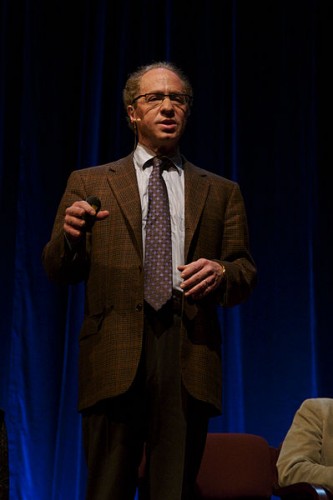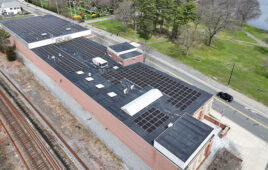
Ray Kurzweil
Futurist Ray Kurzweil made a thought-provoking presentation at a recent trade show for medical device companies, MD&M, in Anaheim, California. At one point during his 45-minute talk he shifted his attention to solar.
Explaining the accelerating rate of technical progress, Kurzweil said technical developments form very predictable trajectories, and those trajectories are exponential. Consider the progress of the computing industry, he said. He spoke about his cell phone, which he said is several billion times more powerful per dollar than the computer he used as an undergraduate at MIT.
“I went to MIT because it was so advanced that it actually had a computer in the late 1960s,” Kurzweil said. “It took up the floor of a building. Still, this cell phone is thousands of times more powerful, and million times less expensive. That’s a several billion-fold increase in price-performance. It’s also a tiny fraction of the size.”
Turning his attention to solar, Kurzweil said four years ago Google founder Larry Page and he were asked by the National Academy of Engineering to study emerging energy technologies. The men selected solar due to its exponential growth. Kurzweil said solar has been around for over 25 years, and its market share has doubled every two years.
“In 2012, solar panels were producing 0.5% of the world’s energy supply. Some people dismissed it, saying, ‘It’s a nice thing to do, but at a half percent, it’s a fringe player. That’s not going to solve the problem,’” Kurzweil said. “They were ignoring the exponential growth just as they ignored the exponential growth of the Internet and genome project. Half a percent is only eight doublings away from 100%.
“Now it is four years later, [and solar] has doubled twice again. Now solar panels produce 2% of the world’s energy, right on schedule. People dismiss it, ‘2%. Nice, but a fringe player.’ That ignores the exponential growth, which means it is only six doublings or [12] years from 100%.”
Two years ago Kurzweil presented this to the Prime Minister of Israel, he said, who had attended his class at the MIT Sloan School in the 1970s. Kurzweil said the prime minster asked him a question.
“Ray, do we have enough sunlight to do this with a doubling seven more times?’” Kurzweil recalled. He said he replied, “’Yes. After we double seven more times, and meeting 100% of the world’s energy needs, we’ll still be using only one part in 10,000 of the sunlight that we have.’”
“It’s not true we’re running out of energy,” Kurzweil said before moving on to another topic. “We’re only running out of resources if we stick with 19th century technologies.”
Reporting by Paul Dvorak, founding editor, Medical Design and Outsourcing
Note: This article, title and text, has been updated to reflect the correct rate of doubling.





Solar is unlikely to reach 100% market share of the world’s energy market in twelve years. The reason isn’t that solar will not continue to grow in utilization, but rather that the consumption of energy will explode, especially in emerging markets, as solar delivers cheap energy to the world’s masses.
What I find interesting is Ray doesn’t mention the global financial system in his prediction. He seems to take it for granted that there will always be a monetary system that can grow exponentially too. The exponential technological developments he references took place from the 1970’s on and that was a period of enormous growth in debt. The planet is starting to hit the wall financially in terms of debt servicing costs and there may not be a way to continue expanding R&D – and most everything else – at those rates.
He also assumes that technological breakthroughs will continue at that rate and that’s also an empirical observation more than a theoretical one.
There may be a vast paradigm shift coming up. If not, it’s an interesting reminder that for all the hubbub about “such important things” like politics, economics, etc., they basically don’t make any significant difference because “progress” is going to continue inexorably practically no matter what.
Peak oilers and energy decent experts and gurus take note:
“It’s not true we’re running out of energy,” Kurzweil said before moving on to another topic. “We’re only running out of resources if we stick with 19th century technologies.”
I disagree with Ray’s conclusion that we’re going to see a 100% increase every two years. First, diminishing returns is a factor in this arena as well as many others. At the moment, photovoltaic installations are in the “low-hanging fruit” stage and almost always come with hefty subsidies. Secondly, EROEI is where the game is played economically. And that hasn’t really budged that much. We’re still looking at a single-digit ratio. And if solar ever becomes dominant, that’s going to mean big economic changes going forward.
Talk about a non-sequitur! What does THAT matter? SOME of us are already positioned for that outcome.
Hey drew..can you tell me how you decided that…what are your qualifications in. This field…
What’s interesting is the experience curve. That’s about 25%, so every time it doubles the cost drops 25%. That’s meaning that in 12 years the cost will be (0.75)**6 or 17% of todays cost… Hopefully where a small Residential Solar PV system may cost $25K, in 12 years it will be about $4500….
Kurzweil has previously said it’s virtually free by ~2036 assuming a 20% reduction for each doubling of capacity (every 2 years). Given that technologies to apply PV film or even spray in a can are in the lab, and that we already produce an abundance of building cladding products that receive insolation then it’s easy to see PV applied as a point of sale feature for a trivial margin cost to cladding manufacturers. At which point energy becomes virtually free, and if it continues to double beyond demand then we have the potential to drive energy intense sequestration technologies that produce building products (concrete etc) that are carbon negative rather than high in carbon footprint.
6 doublings is 12 years, if it is doubling every 2 years…
Thanks, f_p. I’ve updated the article. Journalists are notoriously terrible at math!
I hope he’s correct. Mr. Kurzweil may be right on about the technology, but overestimating humans’ ability to make good decisions. After all, the World could likely be primarily powered by renewables now, if the will to accomplish it existed.
It’s like any other product, as price comes down sales increase. With half the population not even making enough to pay taxes they are lucky to have the will to put food on the table, that is a good decision for their family. When it is economically advantageous it will be more widely adopted.
Patience my good man! 😀
Smart people, who are innovators buy first, the early adaptors prove the technology, they the second tier of adaptors see the benefits the first tier gets, There’s a third tier. And finally a final tier, they pick solar at that point because there is no other choice.